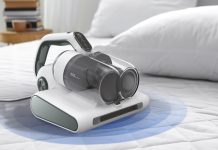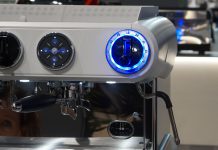Innovative product and process technologies have deeply innovated one of the historical electrical components in the household appliance industry, in particular concerning the electronics use and new quality control applications.
by Roberto Papeschi

The electric motor is one of the historical products of the electrotechnical industry, being the result of several contributions starting from the half of the Nineteenth century, including the fundamental one provided by Galileo Ferraris who in 1885 implemented the first electric asynchronous motor, without applying for the patent. In 1892 the American company Westinghouse, upon patent by the Croatian engineer Nikola Tesla, started producing electric motors on industrial scale. Since then, with the diffusion of the electric energy, the electric motor has contributed in the company’s development, multiplying its product typologies and spreading in the most different applications, from machinery to industrial, civil and sanitary ones, to those connected with durable consumer products, from cars to household appliances and computerized systems. It is thanks to electric motors that fatigue has been eliminated in numerous applications in factories as well as in houses and that an increasing number of functions of the most different industrial and civil applications has been automated.

Electric motors in the household appliance industry
Electric motors have found large use also in the household appliance industry, both for essential functions, as it happens in the washing machine case, where the electric motor is the core of the household appliance, and to carry out auxiliary functions, as in the case of fanned electric ovens. The same happens in refrigerators, in freezers and in the products for the environment conditioning, where the electric motor controls the operation of the compressor, which is the element on which depend all the performances of these household appliances, as it happens in kitchen suction hoods.
Same importance, finally, is hold by electric motors in a broad number of small household appliances, both for their use in kitchen, like food processors, mixers and juicers and in cleaning products, vacuum cleaners, electric brooms and steam appliances, as well as small appliances for shaving, epilation, massage and, more in general, the body care.
In all these products, often the electric motor does not represent the most expensive component but it often constitutes their most critical element, whose bad functioning or failure irreparably damages the use by users while when the defect appears in the production phases in the factory, it constitutes a heavy economic burden for the manufacturer, compelled to expensive repair interventions on finished products. For all these reasons, household appliance manufacturers have always paid utmost attention to the choice of their suppliers, which in their turn have integrated into their production plants sophisticated quality control systems, often based on innovative technologies.
The application field of electric motors in the household appliance industry is very broad. For this reason, it is natural that these components are distributed in numerous product families, suitable for each specific application and very different one another from the technological point of view.

Asynchronous motors
In absolute, the most diffused electric motor still remains the traditional asynchronous single-phase motor, whose configuration recalls the standard electrical direct current motor, of which it maintains the high value of static torque and the high rotation speed. This type of asynchronous single-phase motor is also called “universal motor”, since it can operate both in alternate and in direct current. Actually, when the motor is powered in alternate current, the commutator and the rotor brushes allow keeping the current phases aligned in the two windings, of the stator and of the rotor, as it happens in a direct current motor. Not being self-starting, these motors are equipped not only with the operating winding but also with an auxiliary starting winding that behaves like a second phase, obtained from the same single-phase power supply with the aid of a condenser and shifted 90° out of phase from the first. The main advantages of single-phase asynchronous motors are constituted by their compact sizes, high static torque and high rotation speed. Through the use of opportune electronic devices, in these motors it is also possible to obtain a constant regulation of the rotation speed, particularly important in some applications like those for the washing machine drum motion.

Cage motors
It is also worth noticing that for reduced powers we often use single-phase asynchronous motors whose rotor is made with winding in short circuit, in the configuration commonly called “squirrel- cage”. This cage is obtained by injecting, through a die casting process, an aluminium alloy into the slots of a stack of magnetic laminations opportunely shaped, in order to form in single body both axial bars and the two short circuit loops, upper and lower. The main advantages of these motors, against a minor energy efficiency in comparison with universal motors, are their low cost and the simple maintenance, due to the absence of brushes.

Brushless motors
Today the electric asynchronous motor is more and more often replaced by new brushless motors that, as their name indicates, are without brushes, as well as with independent excitation. In these motors, the current commutation in windings no more occurs mechanically, through contacts sliding on the bars of a commutator positioned on the rotor, but electronically through power transistors controlled by a microcontroller.
Involving a higher price than standard production, brushless motors are characterized by minor overall dimensions with equal power, by minor mechanical resistance and by higher energy efficiency, as well as by lower noise, reduced vibrations and especially minor maintenance needs. It is also worth noticing that in this type of motor, the permanent magnets, positioned on the rotor and replacing the winding under excitation, are made of special materials that allow a very low rotor inertia, thus permitting to achieve a very precise control of the motor, both in speed and in acceleration.
Due to the whole of all these characteristics, the brushless motor is mainly used in those applications where are important the energy saving, the low noise and the absence of vibrations, as well as naturally the constant speed regulation. The typical use examples are those in washing, refrigeration, suction and domestic ventilation appliances, as well as in the environment conditioning. Among the most recent applications, in which the low energy consumption favours the use of brushless motors, we should finally remind those of “wireless” household appliances, first of all vacuum cleaners’ and electric brooms’.
The washing machine motor
Among all electrical motors that find applications in the household appliance industry, the one used in washing machines is undoubtedly the most important, both due to the power at stake and the complexity of the functions characterizing it. In washing machines, in fact, the electrical motor that operates the drum together with the related electronic devices for its regulation, constitutes the core of the product.
In most cases it is a universal alternate current motor, with commutator with bars and brushes, generally positioned in the lower part of the washing machine and mechanically connected with the linen drum by means of pulleys and transmission belt. In some cases, however, in high-end washing machines recently designed, also brushless motors with permanent magnets, directly assembled on the rotation axis of the machine drum, find application.
In any case, to assure the various functions of the washing machine, it is necessary to make use of an effective system for the regulation of the drum speed and then of the motor. This is important not only to generate the various washing and spin-drying speeds, but also to allow a gradual start and stop of the rotation, in order to limit machine vibrations. Besides, once the drum is moving, with the characteristics provided for by each programme phase, the control system must provide for stabilizing the rotation rate, compensating the fluctuations that derive from the variable load and from the interaction of the drum agitators with the linen and with the washing water.
The regulation of the rotation speed of the universal motor in the various phases of the operation cycle (start, stop, washing and spin-drying), is obtained by modulating the alternate electrical current of the power supply by means of electronic power devices (triacs), in their turn controlled by the microprocessor that controls the washing machine programming. The electronic control system, in most cases, is of “closed loop” type (feedback system), using for this the signal of a tachometer sensor.

The quality control
Over the years, quality control systems in the household appliance industry have undergone a constant evolution, involving innovative technologies both in relation to the finished product manufacturing and the component supply, among which the electric motor undoubtedly holds the highest importance. We talked with Marco Pacenti and with Lucia Arcaleni, respectively Business Unit Manager and R&D Engineer of Loccioni Group, which has been operating in this field for over forty years, about the latest technological developments and the applications of measuring and control systems in the household appliance industry.

What are the current market trends?
Even if gradually, the investments in process technologies by the industries producing household appliances have started growing again. In particular, in the sector of quality control systems, besides the standard systems concerning safety and functional tests, new requirements are more and more often emerging.
In this case, what are the tests most frequently demanded?
Besides the main appliance functions, producers are interested in testing the user interface, concerning for instance the pushbutton sensitivity and more in general all that can be included in the definition of “perceived quality” by customers.
In comparison with the past, what are the differences in current control methodologies?
Today, “contactless” measuring systems are gaining more and more space, like vision systems, laser systems and thermography systems, which have proved to be particularly suitable for the new high-automation process systems. In these instruments, the data collection phase is accompanied by a processing and analysis phase, with the use of cutting-edge software able to permit an integrated management of the “on process” quality and accelerated testing of finished products.
What do you mean with “integrated quality management”?
We can find the most significant example of this concept in the European project “Grace”, ended in June last year. This project, of which prof. Paone of Marche Polytechnic University was coordinator and Cristina Cristalli, engineer and Loccioni Innovation Director, was the technical-scientific manager, involved three scientific partners (Marche-Italy Polytechnic University, Polytechnic Institute in Braganca-Portugal and the Sintef Research Centre- Norway), together with three industrial partners (Loccioni-Italia Group, Whirlpool Europe- Italia and Siemens AG-Germany). Grace is a modular production line control system, with particular characteristics of intelligence, flexibility and re-configurability. Thanks to the development and the implementation of a Multi-Agent System (MAS) of collaborative type, the factory automation succeeds in integrating the process control with the quality control, improving the performances of the productive system in its whole, also thanks to the implementation of self-adaptation and self–learning mechanisms.


The production control of electric motors
The complete production control belongs to today’s consolidated tendency of assembling finished products, for which motors themselves are intended, starting from absolutely defect-free components and subsystems and fully complying with designers’ specifications. The replacement cost of the defective component at the end of the assembly process, in fact, would be economically very burdensome, as well as cause of various managerial and logistic problems. It also for this reason that electric motors undergo severe controls during the production process. Controls that start with the preliminary tests of their parts: stator and rotor. Stator and rotor are subjected to electrical safety tests and to the check of the absence of insulation problems, winding defects and short circuits, as well as the control of the correct winding of coils and of the magnetization state of possible magnets. These tests are then followed by the testing of the assembled electric motor, whose most innovative technologies were discussed with Lucia Arcaleni, R&D Engineer of Loccioni Group.
How much is this industrial ambit important for Loccioni Group?
It is in absolute terms, both for the relevance of the electric motor production on a world scale and for the transversal character of applications, which range from the household appliance sector to the automotive industry, just to mention the most important ones.
What are the most innovative technologies that you use in this field?
To understand the innovation level that the market exacts from us, it is first of all necessary to consider that, due to the high quality requested at the line end, the step-by-step control of the motor during its production is more and more important, from single components up to the finished product. For this reason, a couple of years ago Loccioni Group started directly supplying the whole assembly line and no more single test benches, in order to grant the continuous measuring-assembling integration. With this preliminary condition, talking of technology, a production line generally starts with the standard tests of winding insulation and electrical safety verification (on the stator, on the rotor and on the finished product) and it finally ends with noise and vibration measurements for the identification of mechanical defects (bearings, air gap defects, unbalances), acquisition of current/voltage in absorption or in generation (counter electromotive force), of the characteristic torque/speed and then of efficiency. As far as the assembly is concerned, the controls to be carried out clearly vary from customer to customer, depending on the needs and the reference market.
Do you use innovative technologies for these measurements?
The direct noise measuring would require the use of an anechoic chamber to reduce the background noise of the production environment, whose installation is not however simple in line. For this reason we turn to the measurement of different parameters, like vibrations, which are anyway strictly related to the noise ones, considering also that the parallelism between vibration measurements and acquisition of current/voltage data is of great interest.
How does measuring take place in practice?
For measuring the vibrations of a motor while in operation we turn to the use of an accelerometer or of a Laser-Doppler vibrometer, with which, projecting a laser beam on the surface of interest, we evaluate the vibration of the same through the interference between laser beam emitted and the reflected one. The detected data then undergo either time or frequency analyses, FFT, Power Spectrum, STFT, and so on.
How do you proceed concerning performances?
Among the various tests, the motor torque measuring is very significant. This measurement can be executed in lab with the use of a brake. This is not always possible in production, for instance due to the limits of the cycle time, or  because the customer interfaces of the piece are not accessible. For this reason we turn to alternative methods with which to survey the torque information from the measurement of the same in starting phase without braking load (with all the limits connected with the low inertia), or from the motor voltage/current measuring. Still remaining in the torque measurement, it is of particular interest the assessment of the torque ripples (oscillations) connected for instance with the magnetic field interactions at the air gap with the motor geometry, or with the mechanic unbalance or the possible deformations of the magnetic field.
because the customer interfaces of the piece are not accessible. For this reason we turn to alternative methods with which to survey the torque information from the measurement of the same in starting phase without braking load (with all the limits connected with the low inertia), or from the motor voltage/current measuring. Still remaining in the torque measurement, it is of particular interest the assessment of the torque ripples (oscillations) connected for instance with the magnetic field interactions at the air gap with the motor geometry, or with the mechanic unbalance or the possible deformations of the magnetic field.




